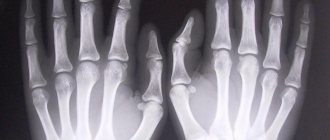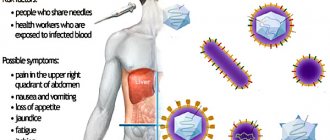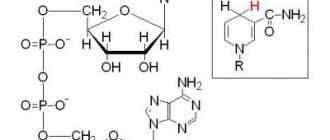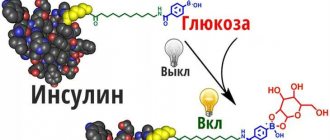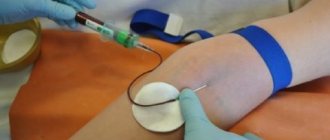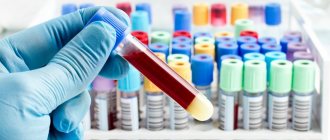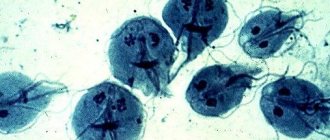A blood test has a lot of useful properties for determining the patient's health status. If there are reasons for taking blood, for example, insufficient insulin production and suspected diabetes, the doctor sets a date for taking the material, where it is possible to detect not only the level of glucose in the analysis, but also cholesterol, which is also important in making a diagnosis. Blood glucose, the norm of which is no more than 5.5 mmol/fasting, can have high levels (hyperglycemia) and low levels (hypoglycemia). The analysis is deciphered only by a doctor, who determines whether the patient’s values are normal or if there are deviations.
What is the difference between blood sugar and glucose?
Hyperglycemia develops due to increased glucose in the blood, plasma or serum. Hyperglycemia is often called the disease of high sugar.
Therefore, many believe that glucose and sugar are one concept that affects hyperglycemia.
The differences between these two concepts can only be understood judging by biochemical analysis. In biochemistry, glucose differs from sugar. Sugar in its pure form is not used by the body for energy balance.
In diabetes mellitus, the patient’s life depends on the sugar (glucose) index in the blood.
How is sugar indicated in a blood test?
Diabetics have to regularly test their blood for sugar. However, not everyone can decipher the information that is hidden under columns of numbers and symbols or Latin names. Many people believe that they do not need this knowledge, because the attending physician will explain the results obtained. But sometimes you need to decipher the test data yourself. This is why it is important to know how sugar is indicated in a blood test.
Types of sugars in the body: complex and simple
The only complex sugars that benefit the body are polysaccharides. They are found only in their natural form in food products.
Polysaccharides enter the body in the form of protein, pectin, starch, and also in the form of inulin and fiber. In addition to carbohydrates, polysaccharides contribute minerals and the necessary complex of vitamins to the human body.
This type of sugar takes a long time to break down in the body and does not immediately benefit from insulin. Polysaccharides do not cause a surge of energy in the body and an increase in strength, as happens after consuming monosaccharides.
A monosaccharide that is the main energy source in the human body and nourishes brain cells is glucose.
Glucose is a simple saccharide that begins the breakdown process in the oral cavity and puts a lot of strain on the pancreas.
The gland must immediately release insulin to break down glucose. This process happens quickly, but the feeling of a full stomach quickly passes and you want to eat again.
Fructose is also a monosaccharide, but it does not need the services of insulin to be broken down. Fructose immediately enters the liver cells. Therefore, fructose is allowed to be consumed by diabetics.
Carbohydrates
Why is a blood glucose test prescribed?
Glucose is a simple carbohydrate, it plays an important role, because the monosaccharide is the main source of energy. Sugar is necessary for every cell of the body for normal functioning and ensuring all metabolic processes.
The glycemic level helps to assess a person’s health status; it is required to maintain it at an acceptable level. Sugar enters the body along with food, then it is broken down by the hormone insulin and enters the bloodstream.
The higher the concentration of sugar in food, the more insulin the pancreas must produce to process it. But it should be understood that the quantitative value of insulin is limited; excess sugar is deposited in the cells of adipose tissue, muscles and liver.
With excessive consumption of sugar, sooner or later a complex system is disrupted and glycemic levels increase. A similar picture occurs when abstaining from food, when a person’s diet does not meet the required norm. In this case:
- glucose concentration drops;
- brain performance decreases.
A similar imbalance is also possible if the pancreas, which is responsible for producing insulin, is not functioning properly.
The main symptoms that should prompt a person to urgently consult an endocrinologist and donate blood for sugar may be excessive thirst, dry mouth, excessive sweating, weakness in the body, increased heart rate and attacks of dizziness.
Official statistics are inexorable; today in Russia about 9 million people suffer from diabetes. It is expected that within 10 years the number of patients with this disorder will double.
Approximately every 10 seconds, 2 new cases of diabetes are confirmed worldwide. During these same 10 seconds, one diabetic dies somewhere in the world, because it has long been known that diabetes is the fourth disease that leads to death.
Expert opinion
Shalaeva Svetlana Sergeevna
endocrinologist, highest category, 18 years of experience
However, it is quite possible to avoid death if you donate blood for sugar in a timely manner and keep the disease under control.
Hormones responsible for the blood glucose index
In order to adjust the glucose entering the body, hormones are needed. The most important hormone in the body for regulation is insulin.
But there are hormones that have counter-insular properties and, when their content is elevated, block the functioning of insulin.
Hormones that maintain glucose balance in the body of any person:
- Glucagon is a hormone that synthesizes alpha cells. Increases glucose and transports it to muscle tissue,
- Cortisol increases the synthesis of glucose by liver cells. Inhibits the breakdown of glucose in muscle tissues,
- Adrenaline accelerates the metabolic process in tissues and has the ability to increase the blood sugar index,
- Somatotropin increases serum sugar concentration,
- Thyroxine or triiodothyronine is a thyroid hormone that maintains normal blood sugar levels.
Only one hormone that can lower blood glucose is insulin. All other hormones only increase its level.
Action of insulin
Do glucose levels change with age?
Normal blood sugar levels should not fluctuate much and be within the normal range of 3.3-5.5 mmol/l. However, there are slight variations depending on how old the patient is.
Fluctuations by age can have the following meaning:
- If the baby's age is from 2 days to 4.5 weeks, blood glucose can range from 2.8 mmol/l to 4.4 mmol/l.
- Older children under 14 years old have indicators from 3.3 – 5.6 mmol/l.
- Normal blood glucose levels in individuals from 14 to 60 years of age range from 4.1 to 5.9 mmol/l.
- In adult women and men from 60 to 90 years of age, blood glucose changes its value in the analysis to 4.6 - 6.4 mmol/l.
- In elderly people over the age of 90 years, the blood may have an amount of glucose of 4.2 - 6.7 mmol/l.
All specified data are approximate and are taken into account by the doctor when undergoing diagnostics. If you are scheduled for a test, take it in the morning on an empty stomach after an 8-10 hour break from your last meal. If diabetes is suspected, a repeat test will be proposed, including blood cholesterol levels.
Normal blood levels
The glucose index is measured in the morning on an empty stomach. To test blood for glucose, capillary, or blood from a vein, is taken.
Table of the normative index according to the patient’s age:
| Age | Normal blood glucose level mmol/l |
| newborn from 2 days to 30 days | 2,80 — 4,40 |
| children from one month to 3 - 4 years old | 3,30 — 5,0 |
| child 4 - 5 years old | 3,30 — 5,0 |
| children from 6 years to 14 years of age | 3,30 — 5,50 |
| from 14 calendar years until the end of life | 3,50 — 5,50 |
In humans, as the body ages, the sensitivity of glucose molecules to the insulin produced by the body disappears.
Therefore, even with normal insulin synthesis, it is poorly absorbed by tissues, and therefore, during analysis, the blood sugar index may be slightly elevated. And this does not mean that a person has hyperglycemia.
Sugar levels
When is a blood test necessary?
A general blood test (CBC), as well as a biochemical test (BAC) are the most informative and simple and therefore common diagnostic methods available to every patient. Based on their results, the doctor can draw initial conclusions about the state of the body and draw up a further examination plan.
Human blood has several hundred different components that carry a specific functional load. Moreover, in order to maintain normal performance, each individual element must meet certain characteristics that are accepted as the norm when conducting multiple tests and studies. Otherwise, it simply will not be able to perform its assigned function.
Interesting! Human blood is regularly renewed. Every hour in adults, 1 billion red blood cells, 2 billion platelets and 5 billion leukocytes die. New cells are formed to replace them, as a result of which 25 ml of blood is renewed in the body over the course of one day.
During a blood test, the doctor receives information about the presence of pathogenic bacteria, the state of immunity, the quantity and quality of hormones and enzymes. In addition, he is able to assess the chemical and physical composition of the blood. CBC implies a comprehensive diagnosis of the body, which makes it possible to determine the signs of various pathologies in the early stages of development.
A blood test is prescribed for all people who come to the hospital for medical help. Taking biomaterial from a finger or vein is a simple and virtually painless procedure, which may be the first step to cure troubling symptoms.
The UAC contains a fairly large number of indicators, many of which are indicated in Latin letters on the form. Separately, we can distinguish coefficients indicating various characteristics of erythrocytes (red blood cells) and leukocytes (white blood cells).
Why does glucose increase?
Some external factors influence the increase in glucose in the body:
- Nicotine addiction
- Alcohol addiction,
- Hereditary genetic predisposition,
- Age-related changes at hormonal levels,
- Obesity, increase in body weight by more than 20 kilograms from normal,
- Constant overstrain of the nervous system, stressful situations,
- Pathology and malfunction of the pancreas,
- Increased sensitivity in the functioning of the adrenal glands,
- Neoplasms in the gastrointestinal tract,
- Pathologies in liver cells,
- Hyperthyroidism disease,
- A small percentage of carbohydrates are absorbed by the body,
- Poor nutrition: fast foods, and quick-to-prepare lunches with a high content of trans fats.
Signs of high sugar
Having explained what letters indicate sugar in a blood test, we will introduce you to the symptoms of high glucose levels:
- Feeling thirsty. This may indicate that your glucose levels are elevated. And this can serve as a sign of diabetes. When the body loses its ability to maintain normal sugar levels, the kidneys work more actively, they take additional moisture from the body. Frequent urges and dehydration occur. A signal is received to replenish water supplies.
- Fatigue. If sugar is not converted into energy, it simply sits in the blood, fatigue sets in, and sometimes you even want to lie down and take a nap.
- Dizziness. Frequent dizziness is a signal to consult a doctor. Possible increase in blood sugar.
- Legs and arms swell. Blood pressure and diabetes lead to kidney problems, followed by improper filtration of fluid, resulting in swelling.
- Tingling, numbness. When the temperature changes, a tingling sensation is felt in the limbs.
- Loss of vision. The sensitive nerve endings in the eyes are damaged as a result of high sugar and blood pressure. The function of the blood vessels in the eyes deteriorates and diabetic retinopathy occurs.
High index symptoms
The first signs of diabetes appear even when a person does not see a doctor about high blood glucose.
If you notice at least one of the signs of hyperglycemia in your body, then this suggests that you need to undergo a diagnostic blood glucose test, establish the reasons for the increase and visit an endocrinologist:
- High appetite and constant feeling of hunger. A person consumes a large amount of food, but there is no increase in body volume. Unreasonable weight loss occurs. The reason is that glucose is not absorbed by the body,
- Frequent urination and urine volume is significantly increased. Polyuria occurs due to strong filtration of glucose into urine, which increases the amount of fluid excreted from the body,
- Increased fluid intake due to extreme thirst. The volume of fluid consumed is more than 5 liters per day. Thirst develops due to irritation of the hypothalamic receptors, and also to compensate the body for the fluid that came out with urine,
- Acetone in urine. The patient also smells of acetone from the mouth. The appearance of acetone is provoked by ketones in the blood and urine, which are toxins. Ketones provoke attacks: nausea leading to vomiting, stomach cramps and intestinal spasms,
- Severe fatigue of the body and weakness of the whole body. Increased fatigue and drowsiness after eating. This fatigue occurs due to a malfunction of metabolic processes and the accumulation of toxins,
- Impaired eye function and decreased vision. A constant process of inflammation in the eyes, conjunctivitis. Clarity in vision disappears and constant fog appears in the eyes. Feeling of clogged eyes
- Itching of the skin, rashes on the skin that turn into small ulcers and erosions and do not heal for a long period of time. The mucous membrane is also affected by ulcers,
- Constant itching in the genitals,
- Decreased immunity
- Intense hair loss on the head.
Therapy for hyperglycemia includes taking groups of drugs in drug courses:
- Group sulfamylurea drug Glibenclamide, drug Gliclazide,
- Biguanide group Gliformin, drug Metfogamma, drug Glucophage, drug Siofor.
These medications gently reduce glucose in the blood, but do not affect the additional production of the hormone insulin.
If the index is very elevated, then insulin is prescribed, which is injected under the skin.
The dosage of the drug is individual and is calculated by the endocrinologist, based on the personal results of all tests.
Increased during pregnancy (gestational diabetes)
Gestational diabetes during pregnancy is often asymptomatic.
But in most cases, signs appear:
- Constant feeling of hunger
- Increased appetite
- Frequent urge to urinate,
- Large volume of biological fluid leaving the body,
- Dizziness when changing head position,
- Headache,
- Sudden change of mood
- Increased irritability
- Increased heart rate
- Blurred vision
- Fatigue,
- Drowsiness.
As soon as signs of incipient gestational diabetes appear, you should immediately consult a doctor to have an examination to determine your sugar level.
Low sugar during pregnancy indicates that the fetal pancreas has begun to produce its own insulin in utero and therefore glucose in the blood of pregnant women drops.
During pregnancy, it is imperative to undergo glucose tolerance testing.
Types of tests for glucose content:
- Blood chemistry . A biochemical blood test can be used both as a disease prevention measure and to determine the stage of an existing disease. Using this method in a biochemical laboratory, you can obtain many important indicators of the functioning of the body, such as glucose balance, etc.
- Blood test for glucose tolerance (GCT) . Using this method, the sugar concentration is determined. Briefly, the essence of the tolerance test: a person takes a blood test on an empty stomach, then no later than 5 minutes he must take a glucose solution, after which he again takes four more tests every half hour. How to dilute glucose for a tolerance test will be described below. Thus, by means of a glucose tolerance test “under load” it is possible to determine the disease of diabetes.
- C-peptide glucose tolerance test . Using this method, a specialist identifies the form of diabetes (insulin dependence), the result of the analysis is the concentration in the body of cells that synthesize insulin.
- Analysis for compounds of glucose with hemoglobin . The World Health Organization defines this test as one of the most important in diagnosing diabetes. It helps control the nature of the disease of types 1 and 2 by monitoring the quantitative change in glycohemoglobin (compounds of glucose and hemoglobin) in the body.
- Analysis for fructosamine concentration . Protein combines with glucose to form the substance fructosamine. Based on its concentration in the human body, the doctor can draw a conclusion about the effectiveness of the treatment prescribed to the patient, and also makes it possible to diagnose so-called latent diabetes in pregnant women and patients with anemia.
- Analysis for the degree of lactation . As a result of the breakdown of glucose anaerobically, lactic acid is formed. The lactic acid balance indicator will tell the specialist about the accumulation of lactate and the possibility of blood acidification disease - a consequence of diabetic disease.
- Analysis of the concentration of sugar in the blood plasma during pregnancy ( glucose tolerance test during pregnancy ). The pregnancy period is dangerous due to the possible development of gestational diabetes, which occurs due to impaired glucose tolerance. The fetus may experience an abnormal increase in volume and weight - this is the definition of the disease macrosomia, which is a consequence of a sharp increase in sugar levels.
- Express diagnostic method . There is a way to determine the glucose balance, which has an error, but it can be done at home. The essence of the method is no different from the laboratory one, but it is simple and quickly done using a special measuring device - a glucometer. A test strip is inserted into the machine and blood is dripped. Within a couple of minutes the result will appear.
Why does glucose drop (hypoglycemia)
The most common cause of low blood glucose concentrations is fasting.
There are also reasons for the development of hypoglycemia when the stomach is not full:
- Long periods of time without food
- Eating too little food (malnutrition)
- Not eating carbohydrates at all,
- Dehydration of the body
- Alcoholic libation,
- Reaction to taking certain medications
- Overdose of insulin (in diabetics),
- Using medications together with alcohol,
- Renal failure
- High loads,
- Pathology in the production of hormones, and increased release of insulin into the blood,
- Malignant neoplasms in the pancreas.
Refusal to consume carbohydrates also does not lead to a normal state of the body. Many hormones are responsible for the level of glucose in the body. Only insulin can reduce it in the body, but many can increase it. Therefore, for a healthy body there must be balance.
A mild form of decreased glucose, when the level drops to 3.8 mmol/l, and also slightly lower.
The average form of glucose drop, when the level drops to 3 mmol/l, and also slightly below this index.
A severe form, when glucose is low and the ratio drops to 2 mmol/l, and also slightly below this indicator. This stage is quite dangerous for human life.
You can increase your glucose levels through diet.
A low-sugar diet includes in its menu the consumption of whole grain bread, fish and lean meat, fermented milk products, and seafood products.
Eating fruits and fresh vegetables in sufficient quantities fills the body with fiber, which helps normalize the level of glucose in the blood.
Fruit juices and teas from medicinal herbs can not only correct the glucose coefficient, but also have a beneficial effect on the entire immune system.
The daily calorie ratio is at least 2100 kcal, and should not exceed 2700 kcal. Such nutrition will be able to adjust the glucose level in the body and allow you to lose several kilograms of excess weight.
Symptoms of hypoglycemia
Symptoms and causes of increased glucose levels
An increase in sugar is the result of a deficiency or excess of one of the important hormones. The most dangerous cause of this is diabetes. Glucose accumulates in the blood because it cannot enter other cells due to impaired insulin release. In type 2 diabetics, the pancreas produces an excess of the hormone, but it is ineffective. People with type 1 diabetes stop producing insulin altogether, so external injections are required.
During pregnancy, hormonal changes in a woman's body can also lead to hyperglycemia. Gestational diabetes is diagnosed.
In 30% of cases, women who have been diagnosed with gestational diabetes develop type 2 pathology after childbirth.
One of the most dangerous causes of increased blood glucose levels is diabetes mellitus.
Symptoms of diabetes are:
- strong constant thirst;
- increased urination and amount of urine;
- decreased immunity and development of genital infections;
- inflammatory processes of the integument (furunculosis, acne);
- weight loss or gain;
- fatigue, weakness;
- itching of the skin and mucous membranes;
- slow healing of wounds.
Hyperglycemia may be a sign of:
- heart attack;
- cerebral hemorrhages;
- endocrine system disorders;
- pancreatic tumors;
- kidney or liver diseases;
- acute pancreatitis.
Signs of diabetes - video
Load tolerance test
Using this method of testing for glucose tolerance, the process of diabetes mellitus in a latent form is checked, and hypoglycemia syndrome (low sugar level) is also determined by this testing.
This test must be completed in the following cases:
- There is no sugar in the blood, but it periodically appears in urine,
- In the absence of diabetes symptoms, signs of polyuria appeared.
- Sugar levels on an empty stomach are normal,
- during pregnancy,
- With a diagnosis of thyrotoxicosis and kidney pathologies,
- Hereditary predisposition, but no signs of diabetes,
- Children who were born with a body weight of 4 kilograms and rapidly gained weight before 12 months of age,
- Neuropathy (non-inflammatory nerve damage),
- Retinopathy disease (damage to the retina of the eyeball of any origin).
Testing for IGT (impaired glucose tolerance) is carried out using the following technology:
- For analysis, blood is taken from a vein and capillary,
- After the procedure, the patient consumes 75 g. Glucose (children's dosage of glucose for the test is 1.75 g per 1 kg of baby's weight),
- After 2 hours, or better after 1 hour, a second venous blood sample is taken.
Sugar curve when testing the body's tolerance to glucose:
| Result | capillary blood | venous blood |
| Standard indicator | ||
| fasting glucose level | 3,50- 5,50 | 3,50 — 6,10 |
| after taking glucose (after 2 hours) | less than 7.80 | less than 7.80 |
| Prediabetes | ||
| on an empty stomach | 5,60 — 6,10 | 6,10 — 7,0 |
| after taking glucose (after 2 hours) | 7,80 -11,10 | 7,80 — 11,10 |
| Diabetes | ||
| fasting glucose | more than 6.10 | more than 7.0 |
| after taking glucose (after 2 hours) | more than 11.10 | more than 11.10 |
Also, based on the results of this testing, the metabolism of carbohydrates in the body after a glucose load is determined.
There are two types of carbohydrate metabolism indicator:
- Hyperglycemic type testing indicator is not higher than the coefficient of 1.7,
- The hypoglycemic coefficient should be no more than 1.3.
The carbohydrate metabolism indicator is very important for the final test results. There are many examples when glucose tolerance corresponds to the norm, and the coefficient of carbohydrate metabolism is higher than the normative level.
In this case, the person becomes at risk for diabetes.
Sugar curve
Some scary numbers
Diabetes mellitus is one of the deadliest diseases in the world . According to statistics, 6 patients diagnosed with diabetes die every minute on the planet. According to approximate data, 6% of Russian citizens are susceptible to this disease and, unfortunately, experts predict the spread of the disease. Thus, in 2025, the number of diabetics is expected to increase to 12% of the country's population.
Separately, it is worth noting the importance of sugar levels during pregnancy and the effectiveness of the glucose tolerance test. During pregnancy, a woman's tissue relationship with the hormone insulin is disrupted : cells react more calmly to the released hormone, as a result of which there is a shift in the balance towards increasing the concentration of sugar in the body. Elevated glucose levels in the expectant mother can cause the risk of gestosis, pyelonephritis, complications of labor and even the threat of spontaneous abortion. Therefore, the need to conduct a glucose tolerance test during pregnancy is obvious in order to be able to timely diagnose biochemical disorders and prescribe appropriate treatment in a timely manner.
Glycated hemoglobin what is it?
To determine sugar, there is another blood test for glycated hemoglobin HbA1C. This value is measured as a percentage. The indicator is always the same at any age, both in adults and in children.
Blood can be donated for glycated hemoglobin at different times of the day, since the glycated hemoglobin level is not affected by any factors.
Blood can be donated after meals, after taking medications, during infectious and viral diseases. With any blood donation for hemoglobin, the result will be correct.
This test method has a number of disadvantages:
- This test differs in price from other studies; the test is expensive,
- If the patient has a reduced ratio of the hormones produced by the thyroid gland, then the test result may be slightly increased,
- In case of anemia, low hemoglobin, the indicator may be underestimated,
- Not all clinical laboratories perform this testing,
- Reduced index with long-term intake of vitamin C, as well as vitamin E.
Decoding of glycated hemoglobin standards:
| From 6.5% | Untested diabetes. The need for additional diagnostics. |
| 6,1-6,4 % | Borderline diabetes. |
| 5,6-6,0 % | High chance of developing diabetes. |
| Lower than 5.6% | Minimal risk of diabetes. |
With Latin letters
Sugar in a blood test is designated by the Latin letters GLU. The amount of glucose (GLU) should not exceed 3.3–5.5 mmol/l. To track health status in biochemical tests, the following indicators are most often used.
- Hemoglobin HGB (Hb) : the norm is 110–160 g/l. A smaller amount may indicate the development of anemia, iron deficiency or folic acid deficiency.
- Hemocrit HCT (Ht) : the norm for men is 39–49%, for women – from 35 to 45%. In diabetes mellitus, the rates usually exceed these parameters and reach 60% or more.
- Red blood cells RBC : norm for men - from 4.3 to 6.2 × 10 12 per liter, for women and children - from 3.8 to 5.5 × 10 12 per liter. A decrease in the number of red blood cells indicates significant blood loss, lack of iron and B vitamins, dehydration, inflammation, or excessive exercise.
- White blood cells WBC : normal 4.0–9.0 × 10 9 per liter. A deviation upward or downward indicates the onset of inflammatory processes.
- Platelets PLT : the optimal amount is 180 – 320 × 10 9 per liter.
- Lymphocytes LYM : in percentage terms, their norm ranges from 25 to 40%. The absolute content should not exceed 1.2–3.0 × 10 9 per liter or 1.2–63.0 × 10 3 per mm 2. Exceeding the indicators indicates the development of infection, tuberculosis or lymphocytic leukemia.
In diabetes, a significant role is played by the study of erythrocyte sedimentation rate (ESR), which indicates the amount of proteins in the blood plasma. The norm for men is up to 10 mm per hour, for women – up to 15 mm/hour. It is equally important to monitor good and bad cholesterol (LDL and HDL). The normal value should not exceed 3.6–6.5 mmol/l. To monitor kidney and liver function, you should pay attention to the amount of creatine and bilirubin (BIL). Their norm is 5–20 mmol/l.
Determining blood sugar with a glucometer
At home, you can measure blood glucose using a glucometer.
Technology for measuring glucose using a glucometer:
- Measure only with thoroughly washed hands,
- Place the test strip in the device,
- Prick your finger
- Apply blood to the strip
- The glucometer takes measurements within 15 seconds.
Based on the glucometer readings, you can adjust your sugar levels using diet or medication.
Types of glucose tests
In addition to standard blood and urine tests, there are additional laboratory methods. The full list of tests for glucose looks like this: standard analysis, urine test for sugar, glycated hemoglobin, glucose tolerance test, glycosylated albumin (fructosamine).
Glucose tolerant
Glucose tolerance test is a research method that shows the amount of sugar taking into account the load.
It allows you to consolidate the level and dynamics of indicators. Rented in several stages with an interval of half an hour. First, the value is determined on an empty stomach, then “with a load”, after which the intensity of the decrease in concentration is monitored. You are not allowed to smoke, drink or eat during the entire procedure. Before the study, general preparation rules are taken into account. GTT is not performed after operations, childbirth, heart attacks, or during acute inflammatory processes. Not prescribed for diabetics with fasting sugar levels >11 mmol/l.
Glycated hemoglobin
Glycated hemoglobin is a type of test that displays glucose levels over a long period. It is often prescribed to diagnose the disease. It is an indicator for assessing the risks associated with diabetes.
Its level is not affected by the time of day or food intake. As a rule, it does not require special preparation and is carried out at any time.
GG is necessary to assess the level of compensation for diabetes. High test results indicate the presence of high glycemic levels for four months.
If deviations from acceptable values occur, adjustments are made with glucose-lowering therapy. Normalization of indicators is achieved a month after the measures taken.
Designation in Latin letters HbA1c.
Glycosylated albumin
Fructosamine is a special complex of glucose and blood proteins. One of the methods for diagnosing diabetes and monitoring the effectiveness of therapy. In contrast, GG demonstrates average blood sugar levels for 21 days before testing.
Designated for short-term monitoring of indicators. Elevated values may indicate the presence of diabetes, hypothyroidism, or renal failure. Reduced values indicate diabetic nephropathy, hyperthyroidism. General clinical training rules are followed.
How to take the test correctly?
Preparing the body for the required test is carried out a day before the test, adhering to strict rules so that you do not have to visit the clinical laboratory several times:
- According to the method, venous and capillary blood is taken for examination.
- Blood is drawn in the morning
- The procedure is carried out on a hungry body and it is advisable that the last meal is no earlier than 10 hours before blood donation,
- The day before the test, it is not recommended to eat fatty foods, smoked foods, marinades and pickles. It is strictly forbidden to consume sweets, alcohol and avoid taking medications for one day,
- Do not take ascorbic acid
- Do not donate blood during a course of medication with antibacterial drugs,
- Do not overload the body physically and emotionally,
- Do not smoke 120 minutes before the pick-up.
Failure to comply with these rules leads to inaccurate information.
If the analysis is performed from venous blood, then the standard glucose value increases by 12 percent.
Other methods for determining the index
Fluid from the spinal cord cannot be collected at home. This is a rather complex procedure for collecting material for a diagnostic study of glucose levels in the body.
This lumbar puncture procedure is performed quite rarely when, together with a puncture for glucose, it is necessary to study the functionality of the bone marrow.
The patient collects urine for glucose testing himself. You need to collect the daily dose of urine in one container. For diagnostic testing, separate the required amount of liquid and bring it to the clinical laboratory.
The patient measures the total amount himself; this indicator is also important in diagnosis.
The normal value in urine glucose is 0.2 g/day (less than 150 mg/l).
High glucose index in krin, reasons:
- Diabetes mellitus,
- Glucosuria of a renal nature,
- Intoxication of kidney cells
- Glucosuria during pregnancy in women.
It is recommended to analyze urine for sugar together with a blood test.
This makes it possible to more accurately determine the causes of pathology of deviations from the norm in the level of glucose in the body.
Sugar analysis: how to prepare correctly?
To get a normal glucose level, you need to know about simple rules for preparing for analysis:
- Pickup time starts at 7 a.m. and usually ends at 11 p.m.
- It is not recommended to take a sugar or cholesterol test after eating, so you should take it on an empty stomach.
- Data results may not be accurate if you are taking antibiotics.
- Alcohol intake and fatty foods may change the test value.
- Eliminate physical and emotional stress.
This applies to conventional biochemical analysis. Other blood tests have other requirements that should be checked with your doctor.
Diet
How to reduce the blood glucose index? Using a diet that involves excluding carbohydrates from the menu, which are quickly absorbed by the body. And replacing them with products that have a long breakdown period and do not require large amounts of insulin.
Each food product has its own glycemic index, which is the product’s ability to increase glucose in the blood.
And it is very important for a diabetic to eat foods with a lower glucose index:
- Onions, garlic, herbs,
- Tomatoes and tomato juice,
- All types of cabbage
- Green peppers, fresh eggplants, cucumbers,
- Young zucchini
- Berries,
- Nuts, unroasted peanuts,
- soybeans,
- Fruits,
- Legumes, lentils, black beans,
- 2% fat milk, low-fat yogurt,
- Soy tofu cheese,
- Mushrooms,
- Strawberry,
- Citrus,
- White beans,
- Natural juices,
- Grape.
Products with a high glucose index that should be completely avoided are:
- Bakery products and baked goods made from wheat flour,
- Baked pumpkin,
- Potato,
- Sweets,
- Condensed milk,
- Jam,
- Cocktails, liquor,
- Wine and beer.
Diet for high glucose
Products with average glucose levels are recommended to be limited in use.
These products include:
- Wheat bread with added bran,
- Natural juices,
- Oatmeal,
- Pasta,
- Buckwheat,
- Yogurt with honey
- Oatmeal gingerbread,
- Berries of sweet and sour varieties.
Diabetic diet No. 9 is a specialized diet for diabetics, which is the basis for the diet at home.
The main dietary dishes of this diet are soups with light meat or light fish broth, as well as vegetable and mushroom broth.
Protein should come with poultry meat, boiled or stewed.
Fish food fish of non-fatty varieties, prepared by boiling, stewing, steam bath, open and closed baking.
Food products are prepared with a low percentage of salt.
The method of frying foods is strictly prohibited if there is high blood glucose.
You can adjust your glucose index using foods. With strict adherence to the diet, you can do without the use of medications for a long period.
Interpretation of indicators and their meanings
A blood test has a lot of symbols, and finding sugar among them is not difficult if you know how it is formulated.
Biochemical analysis and its interpretation:
- Total protein is the amount of protein in the donor’s blood, which is directly involved in its coagulation and transportation of various substances throughout the body.
The norm depends on age - 64/8p g/l for an adult.
Excess - various infectious diseases, arthritis or even oncology.
- Glucose (Glu) is the blood sugar that is most important for diabetics. Responsible for the entire carbohydrate metabolism process in the body.
The norm is 3.30-5.50 mmol/l.
Increase – diabetes mellitus.
- Urea is formed as a consequence of the breakdown of proteins in the body.
The norm is 2.5-8.3 mmol/l.
Increased – diseases of the kidneys, intestines and urinary system.
- Cholesterol (LDL, HDL), involved in the metabolic processes of fat cells and the body's production of vitamin D. It directly affects sex hormones.
The norm is 3.5-6.5 mmol/l.
Excess – atherosclerosis, cardiovascular diseases, liver diseases.
- Bilirubin (BIL) is formed during the breakdown of hemoglobin and is itself an orange pigment.
The norm is 5-20 mmol/l.
Increased – B12 deficiency, jaundice, oncology.
- Creatinine is an indicator of kidney function. Participates in the energy exchange of tissues.
The norm is 53-115 µmol/l, the range is large due to the direct relationship of the patient’s weight, which affects the indicators.
Increased – renal failure.
- α-amylase is involved in the process of breakdown and absorption of carbohydrates.
Norm –28-100 units/l; pancreatic – 0-50 units/l.
Increased – peritonitis, diabetes mellitus, etc.
- Lipase is one of the enzymes produced by the pancreas. Promotes the breakdown of fat cells.
The norm is 190 units/l.
Excess – pancreatic disease.
- Alanine aminotransferase (ALAT, ALT) is a special-purpose enzyme. Used to diagnose liver conditions. Occurs in the blood due to the destruction of liver, heart or kidney cells.
The norm is 41 units/l in males and 31 units/l in females.
Exceeding symbolizes the rapid death of organ cells.
In brackets there is a designation in Latin letters or abbreviations, which are used mainly when testing blood for sugar.
Biochemical is considered a special subtype of general analysis. It is carried out only if the doctor has identified deviations from the norm in the general analysis report indicating a certain disease. Thus, it is clarified what specific disease arose in the patient, and only after a biochemical analysis is a more targeted diagnosis carried out.
In biochemical analysis, sugar is designated as glucose or its Latin abbreviation - Glu. The limited limits of the norm are ready to accurately indicate to the physician whether the patient has diabetes. Depending on how much the actual data differ from the norm, appropriate conclusions are drawn regarding the type of disease.
Since glucose is additionally responsible for the process of carbohydrate metabolism in the body and is produced by the pancreas, it can be concluded that diabetes occurs due to a violation of the digestive system in some cases. Concomitant diseases are also determined by the same biochemical analysis, the data of which can be easily deciphered after familiarization with the indicators and their meanings.
ul
Medical term
The terminology “blood sugar, sugar test” has become part of the daily speech of citizens. But among medical terminology there is no such concept as blood sugar, because sugar consists of a large number of elements. So the correct name is blood glucose test.
There are 4 methods for determining blood glucose, namely:
- Laboratory - analysis is carried out in medical institutions. The main advantage is obtaining a 100% reliable result.
- Express - carried out using a home device called a glucometer. When using this device, blood from your finger should be applied to a special test strip. You can get the result in a couple of seconds. The disadvantage is the receipt of unreliable information (error up to 20%) due to non-compliance with the rules for caring for the device.
- Load analysis – blood testing is performed in 2 stages. Read more about this method in our article.
- Glycated hemoglobin - thanks to this technique, you can determine your sugar level over the past 3 months. This method is most often used in the treatment of diabetes.
ul
Cost of tests
The price of ACS depends on the organization where the blood is drawn. The cheapest way is a government agency. In state clinics, AKS will be free or the cost will be up to 300 rubles. In private clinics, this analysis will cost from 400 rubles.
In addition, you can monitor your glucose levels without leaving home. To do this, it is enough to purchase a glucometer, the approximate cost of which is 900-1600 rubles, and the cost of testers is 50 rubles per package.
ul
How to submit?
To obtain reliable results, the patient must prepare for the analysis as follows:
- It is forbidden to eat food 8-12 hours before the test.
- You can drink regular water.
- 2 days before the ACS, you should not drink alcohol or eat fatty, fried foods.
- On ACS day, you should not brush your teeth or use chewing gum, since toothpaste and chewing gum contain sugar.
- You cannot take medications for 3 days. If such cancellation is not possible, then the patient must notify the doctor.
- The test must be taken before 9 am.
- The day before ACS, you cannot perform serious mental (physical) work.
- Smoking is prohibited on the day of the ACS (before the actual collection).
- You cannot donate blood after therapeutic procedures (for example, massage, ultrasound, x-ray).
- If colds or inflammatory diseases develop, ACS should be postponed until after recovery.
ul
The norm among children and adults
The norm among women and men is the same - 3.5-5.5 mmol/l (from a finger) and 3.7 - 6 mmol/l (from a vein). If the analysis needs to be done urgently, then the readings will vary between 4-7.8 mmol/l.
Newborns have glucose levels of 2.8-4 mmol/l; in older age, the norm is up to 5 mmol/l. After reaching 6 years of age, the norm of sugar concentration is identical to that of adult patients.
The glucose norm is fixed in the following table:
| Age criteria | Norm, mmol/l |
| Up to a year | 2,8-4,4 |
| Children from 1 year | 3,3-5 |
| Adults | 3,5-5,5 |
| Pregnant women | 3,8-5,8 |
Each laboratory has its own sugar norms. Therefore, the laboratory assistant or doctor must inform about the standards on the basis of which the interpretation was made.
In addition, it is worth considering a number of features when determining the norm, namely:
- diabetics: the norm is 6 mm/l or more;
- a value between 5.5-6 mm/l refers to an intermediate state - in such a situation the doctor makes a diagnosis called “impaired glucose tolerance”;
- after eating, glucose level is below 10 mm/l;
- The rate of the glycated method varies between 6.5-7% (more details in the next chapter).
How to lower blood sugar?? Read the link.
ul
Glycation analysis
Thanks to this method, you can determine how successful your diabetes treatment is. Such an analysis must be taken once a week for 3 months in one laboratory.
Important! Doctors refer to glycation analysis as follows: A1C, HbA1C.
In addition, a glycation test is required if there are symptoms such as: slow wound healing; fatigue; fruity breath; frequent urination; sudden deterioration of vision; dryness (mouth).
First of all, the risk group includes:
- obese persons;
- pregnant women;
- persons leading a passive lifestyle;
- employees of hazardous production;
- patients who drink a lot of alcohol;
- women who have polycystic ovary syndrome (leading to infertility);
- patients with low cholesterol levels;
- heredity to diabetes.
Blood is taken from a finger at any time of the day, but doctors recommend donating blood on an empty stomach in the morning. The results will be ready in 2 days.
Important! The norm of glycated hemoglobin is 4-9%. In diabetics, these indicators are 2 times higher.
It is worth highlighting the pros and cons of this method, and let's start with the advantages:
- It is not necessary to take tests on an empty stomach.
- This method allows you to identify the disease at an early stage of development.
- The analysis is carried out quickly and without preparation.
- Accuracy of the results obtained.
- The test helps determine how well the patient controls their sugar levels.
- The results obtained do not depend on the use of medications, physical activity, or the emotional (or physical) state of the patient.
The disadvantages of the analysis are the following:
- high cost - from 500 to 2000 rubles;
- with anemia or hemoglobinopathy (impairment or change in the structure of the hemoglobin protein), the results may be inaccurate;
- This test cannot be taken in all clinics or laboratories;
- indicators increase with increased levels of thyroid hormones.
For more information about glycated hemoglobin, see the following video:
https://youtu.be/4bY8rneaHokul
What does load analysis mean?
Glucose tolerance test is another name for ACS with stress. With this test you can find out how the body reacts to insulin, which is produced in the pancreas.
Doctors prescribe a glucose tolerance test in the following situations:
- suspected diabetes mellitus;
- polycystic ovary syndrome;
- overweight;
- metabolic syndrome (occurs when the body's cells do not respond to the produced pancreatic hormone);
- diabetes;
- pathologies in the digestive system.
ACS with load occurs in several stages, namely:
- Receiving a referral for analysis.
- Preparation as follows: do not eat 12 hours before blood sampling; tests must be taken in the morning; You cannot drink or eat during the test; 2 days before blood sampling, it is necessary to exclude fatty foods, physical activity, stress, alcohol, smoking, and taking medications.
- The clinic performs the first blood sampling from a finger.
- After the analysis, you should consume 100 grams of glucose in the form of tablets or solution (for an adult, 250 ml of liquid must be diluted with 100 grams of glucose).
- After 2 hours, another blood sample is taken from a vein.
The results will be ready 2 hours after the second blood draw. The norm is up to 7.8 mm/l.
ACS with load is contraindicated in the following cases: infectious and inflammatory diseases; toxicosis; postoperative period; allergy to glucose; exacerbation of gastrointestinal pathologies.
At the end of the article, it is worth noting that a sugar test should be taken not only if diabetes is suspected, but also for prevention at least once a year. Read more about the features of this analysis in our article.
You might be interested in:
How can you lower blood sugar?
All the most important and interesting things about biochemical blood tests
Calcium levels in adults and children
Blood test for herpes
Blood test and alcohol
ul
What to do if you have diabetes?!
We recommend reading an exclusive article on how to forget about diabetes forever... Read more >> |
How is blood sugar indicated in Latin letters?
Most of the blood test results are performed on hematology analyzers, which can automatically calculate up to 24 parameters simultaneously. Designations are written in Latin letters, followed by the obtained laboratory data.
Expert opinion
Kovaleva Elena Anatolyevna
Doctor-Laboratory Assistant. 14 years of experience in clinical diagnostic services.
To indicate blood sugar, the following combination of Latin letters is used - GLU (Glucose) or glucose. The concentration is indicated in mmol/l. Normally, this figure varies from 3.89 to 6.38 mmol/l.
These indicators are indicated only when conducting a biochemical or special medicinal blood test for glucose.
ul
In detailed analysis
Finding out your sugar level when receiving a detailed blood test is quite simple. This data is indicated in a line designated in Latin letters GLU or Glucose.
As mentioned above, according to the norm, this figure should not be lower than 3.89 mmol/l and higher than 6.38 mmol/l.
An indicator that is too low or too high may indicate a danger to human health.
A decrease in sugar levels to 2 mmol/l can lead to critical disturbances in the functioning of the human central nervous system.
Detailed blood tests are also used to determine average sugar levels over a period of up to three months. This test is prescribed to detect diabetes mellitus.
The results are interpreted by determining the percentage of hemoglobin in the blood that binds to glucose molecules. This reaction is called the Maillard reaction. This reaction occurs faster and the level of glycated hemoglobin in the blood increases if glucose levels are elevated.
ul
In general analysis
In a general blood test, you can see only a few parameters, for example, the erythrocyte sedimentation rate, the amount of hemoglobin, the number of blood cells and others.
A general blood test is designed to determine blood diseases and detect inflammatory processes in the body.
This analysis is prescribed to determine the general condition of the body.
Blood sugar levels cannot be determined using a general blood test.
But, when deciphering an indicator such as hematocrit or RBC, one can judge the suspicion of diabetes, that is, a decrease in blood glucose levels. This indicator indicates the ratio of red blood cells and plasma in the blood. Normal levels range from 2 to 60%. If the indicator increases, a person may be diagnosed with diabetes.
ul
Special blood test for sugar
A special blood sugar test is prescribed to detect diabetes mellitus, endocrine disorders in the body, epilepsy, and pancreatic diseases.
There are several types of blood sugar tests:
- laboratory;
- express analysis using a glucometer;
- glucose tolerance test or exercise test;
- analysis for glycated hemoglobin.
Expert opinion
Kovaleva Elena Anatolyevna
Doctor-Laboratory Assistant. 14 years of experience in clinical diagnostic services.
As in a detailed blood test, you can find out your glucose levels in the line with the same name. Normal values for a healthy person range from 3.3 to 5.5 mmol/l. If the indicator is higher, the person most likely suffers from diabetes.
If the readings are below normal, we may be talking about hypoglycemia.
Sugar levels may have the following indicators:
- 5.5 -5.7 mmol/l (when a person is healthy);
- 7.8 mmol/l or 7.8-11 mmol/l two hours after eating (the person has impaired glucose tolerance);
- 7.8 mmol/l or more than 11.1 mmol/l two hours after eating (for diabetes).
ul
Prevention of hyperglycemia and hypoglycemia
Prevention of hypoglycemia and hyperglycemia requires a certain diet:
- Eat more natural foods and avoid ready-made meals that are rich in trans fats,
- Avoid foods that overload the liver
- Eat more fiber
- In case of hypoglycemia, eat a large amount of protein foods.
If the disease is secondary, then it is necessary to simultaneously treat the underlying disease that caused hypoglycemia or hyperglycemia.
Diseases that provoke deviations from normal blood glucose:
- Liver pathology, hepatitis,
- liver disease cirrhosis,
- Oncological neoplasms in liver cells,
- Pathology in the functionality of the pituitary gland,
- Disorders of the pancreas.
A healthy lifestyle plays a huge role in preventing blood glucose abnormalities. Bad habits, stressful situations, overload of the body, negatively affect both the increase in sugar and its decrease.
Decoding the result
Increased glucose levels (hyperglycemia)
Observed in the following diseases and conditions:
- Diabetes.
- Gestational diabetes (diabetes during pregnancy).
- Physiological hyperglycemia, causes: moderate physical activity, strong emotions, stress, smoking, adrenaline release after injection.
- Active infectious process.
- Trauma, recent surgery.
- Endocrine system diseases:
- a) pheochromocytoma - a tumor of the adrenal glands that produces adrenaline and is characterized primarily by a persistent increase in blood pressure; b) thyrotoxicosis – a pathological condition in which the thyroid gland begins to produce too many hormones (thyroxine and/or triiodothyronine); c) acromegaly is a disease associated with a violation of the synthetic activity of the pituitary gland (a gland located in the brain). It is characterized by excess production of growth hormone, leading to changes in facial features, enlargement of the hands and feet. d) gigantism - a pathology, also associated with the pituitary gland, is hereditary in nature, the first manifestations occur in early adolescence; e) Itsenko-Cushing syndrome is a condition in which the adrenal glands produce excessive amounts of cortisol. Characterized by a violation of carbohydrate metabolism; f) somatostatinoma - a tumor of hormonally active cells of the pancreas or cells located in the wall of the duodenum, secreting somatostatin; g) polycystic ovary syndrome - a symptom complex accompanied by the formation of cysts in the ovaries, menstrual irregularities, excess body weight, and infertility.
- Diseases of the pancreas (acute and chronic pancreatitis, pancreatitis with mumps, cystic fibrosis, hemochromatosis, pancreatic neoplasms).
- Chronic liver and kidney diseases.
- Cerebral hemorrhage, myocardial infarction.
- Taking thiazide diuretics, beta blockers, caffeine, oral contraceptives, glucocorticoids (a full list is presented in the section “What may affect the results”).
Low glucose levels (hypoglycemia)
- Patients with diabetes may experience low glucose levels in the following situations:
- a) insulin overdose; b) overdose of drugs that lower blood glucose levels; c) increased physical activity; d) skipping meals; d) drinking alcohol.
- Severe liver diseases (cirrhosis, hepatitis, carcinoma, hemochromatosis).
- Tumor diseases: pancreatic cancer, adrenal cancer, stomach cancer, fibrosarcoma.
- Reactive hypoglycemia is a condition in which blood glucose levels decrease 1-3 hours after eating.
- Dietary disorders (prolonged fasting, malabsorption syndrome - impaired absorption of nutrients due to intestinal diseases).
- Taking large doses of alcohol.
- Intense physical activity.
- Feverish conditions.
- Taking a number of medications:
- a) beta blockers (atenolol, propranolol, etc.) – used in the treatment of coronary heart disease, hypertension; b) flecainide and quinidine (drugs for arrhythmia); c) indomethacin (painkiller); d) insulin and other hypoglycemic drugs; e) some antibiotics, antifungal drugs; e) aspirin; g) a number of antiepileptic, anti-anxiety drugs (pregabalin); h) monoclonal antibodies for the treatment of tumor or autoimmune diseases.
Conclusion
Carbohydrate metabolism in the human body depends on the accumulation of fat, which increases body volume and leads to disturbances in hormonal synthesis, which in turn leads to insufficient insulin production.
With a lack of insulin, the level of glucose in the blood increases, and hyperglycemia (diabetes mellitus) develops.
Timely diagnosis using clinical analyzes and glucose tests will allow you to begin to fight pathology at the initial stage of glucose deviation from the standards.
Glucose level
First of all, it should be noted that from a medical point of view it is correct to say “glucose level”. Sugar consists of a whole group of substances, but glucose is determined in the blood. But the term “blood sugar” itself has so confidently entered into speech that it is used in this form not only in conversations, but also in medical literature. Sugar is indicated in a blood test by the Latin letters GLU, from the word “glucose”.
First of all, this indicator informs us about the state of carbohydrate metabolism in the body. Glucose comes with complex carbohydrates, which are broken down in the gastrointestinal tract and enter the bloodstream. Hence the conclusion that in various diseases of the gastrointestinal tract, the absorption of glucose may be impaired. The glucose that enters the blood is only partially used by the body; most of it is deposited in the form of glycogen in the liver. Further, in emergency cases (emotional, physical stress), glycogen is broken down and glucose is released into the blood.
Conclusion - the liver is a storehouse of glucose, so when it is diseased, blood sugar levels may also change. The neuroendocrine system, adrenal glands, and pancreas are responsible for the exit from the liver, synthesis, and absorption of glucose. Therefore, the pathology of any of these organs causes a malfunction in blood sugar levels.



